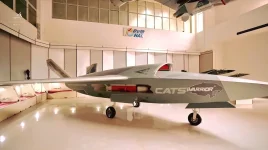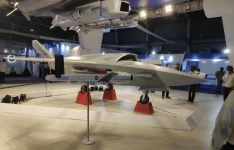- Views: 2K
- Replies: 15
India's pursuit of advanced aerial weaponry includes the proposed CATS Hunter Air Launched Cruise Missile (ALCM) from Hindustan Aeronautics Limited (HAL).
Designed as a stealthy, subsonic missile capable of flying close to the surface, the Hunter can be launched from both crewed aircraft and unmanned platforms.
Despite its modern design, featuring the PTAE-7 turbojet engine, the project currently awaits approval from the Indian Air Force (IAF) and the Ministry of Defence (MoD).
The IAF's hesitation appears linked to a strategic shift favouring faster, potentially lower-cost supersonic ALCMs and powered glide bombs. This change in priority is reportedly influenced by observations from the conflict in Ukraine, where subsonic cruise missiles have shown vulnerability against contemporary air defence systems.
This evolving requirement landscape includes several competing indigenous projects like the ADE's ITCM, BrahMos Aerospace's BrahMos-NG, and JSR Dynamics' jet-powered glide bomb, creating a complex picture for India's future air-launched strike capabilities.
CATS Hunter: Design and Capability
Developed as part of HAL's futuristic Combat Air Teaming System (CATS) initiative, the Hunter missile is engineered for precision strikes while maintaining a low profile against enemy radar. It utilizes the PTAE-7 turbojet engine and was initially conceived with a 200 km range carrying a 250 kg warhead.Its ability to skim just above the ground or sea surface is a key feature for evading detection. While HAL had considered a reusable version, recent focus seems to be on extending the missile's range.
The Hunter's versatility is a significant aspect, designed for launch from fighters like the Su-30MKI and unmanned systems like the CATS Warrior drone – a 'loyal wingman' concept HAL is actively developing. This aligns with the global trend of integrating unmanned platforms with manned aircraft, reflecting the IAF's own vision for Collaborative Combat Aircraft (CCA).
However, its subsonic speed remains a concern, especially when considering lessons from recent conflicts about the survivability of slower munitions against advanced air defences.
IAF's Strategic Reassessment
The performance of subsonic cruise missiles in the Russia-Ukraine war has prompted a strategic rethink within the IAF. Missiles like Russia's Kalibr and Kh-101 have reportedly faced significant interception rates (estimated at 60-70% in some cases) by modern air defence systems such as the S-400, Pantsir, and Western-supplied systems like the Patriot PAC-3 used by Ukraine.This experience suggests that slower missiles struggle against capable, integrated air defence networks. Consequently, the IAF is showing a preference for supersonic weapons that are harder to intercept and can reach targets faster.
India already operates the formidable BrahMos-A supersonic missile (flying at Mach 2.8-3.0), launched from Su-30MKI fighters. Its range has been upgraded significantly, reportedly up to 800 km for newer land-attack versions.
The Defence Acquisition Council recently approved acquiring around 250 more BrahMos missiles for the Army and Air Force. However, the high cost of BrahMos necessitates exploring more cost-effective supersonic alternatives for wider deployment.
Competing Indigenous Programmes
The CATS Hunter is not the only indigenous system vying for the IAF's attention:- ADE's ITCM: The DRDO's Aeronautical Development Establishment (ADE) has developed the Indigenous Technology Cruise Missile (ITCM). This subsonic missile, powered by the indigenous Manik engine, reportedly boasts a range exceeding 800 km and was successfully flight-tested in April 2024. Its lighter weight allows carriage on various IAF fighters, including Tejas, MiG-29, and Rafale, offering a potentially cost-effective long-range option, though its subsonic speed remains a factor.
- BrahMos-NG: BrahMos Aerospace is working on the BrahMos Next Generation (NG), a smaller, lighter (around 1.3-1.6 tonnes) supersonic missile compared to the BrahMos-A. Expected to reach Mach 3.5 with a range of 290-300 km, its reduced size will enable integration onto platforms like the Tejas and Rafale. It aims to retain the original BrahMos's high speed and precision, making it difficult to intercept. The first flight test is anticipated around 2026, with production potentially starting by 2027-28.
- JSR Dynamics' LRGB: Representing the private sector, JSR Dynamics offers a jet-powered version of its Long Range Glide Bomb (LRGB). By adding a small jet engine to a standard glide bomb (like the Mk-80 series warheads), this weapon achieves a range of up to 290 km. It presents a potentially cost-effective solution for stand-off strikes, balancing range and affordability, though it differs in capability from dedicated cruise missiles. DRDO has also successfully tested its own 1000kg LRGB, named 'Gaurav', achieving nearly 100 km range.
Future Prospects
While the trend leans towards supersonic speed, the CATS Hunter's specific design features – its stealth shaping and low-altitude flight – could still provide valuable tactical advantages, particularly against less advanced air defence networks or when deployed from unmanned platforms to minimize risk in highly contested zones.Its role within the broader CATS ecosystem, integrating manned and unmanned assets, continues to align with future air warfare concepts.
The final decision on the Hunter ALCM rests with the IAF and MoD as they balance capability requirements, cost-effectiveness, and the evolving lessons from modern battlefields.






